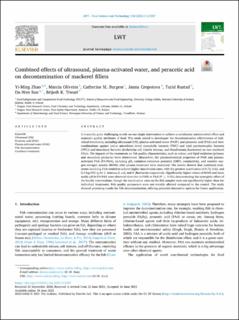| dc.description.abstract | It is usually quite challenging to rely on one single intervention to achieve a satisfactory antimicrobial effect and maintain quality attributes of food. This study aimed to investigate the decontamination effectiveness of individual treatments, including ultrasound (US), plasma-activated water (PAW), and peracetic acid (PAA) and their combinations against native microbiota (total mesophilic bacteria (TMC) and total psychrotrophic bacteria (TPC)) and inoculated bacteria (Escherichia coli, Listeria innocua, and Pseudomonas fluorescens) on raw mackerel fillets. The impacts of the treatments on fish quality characteristics, such as colour, and lipid oxidation (primary and secondary products) were determined. Meanwhile, the physicochemical properties of PAW and plasma-activated PAA (PA-PAA), including pH, oxidation-reduction potential (ORP), conductivity, and reactive oxygen nitrogen species (RONS) after plasma treatment were examined. The results showed that combined treatments involving PAA tended to achieve higher inactivation rates, with the greatest inactivation of 0.72, 0.62, and 0.5 log CFU/g for L. innocua, E. coli, and P. fluorescens respectively. Significantly higher values of RONS and more acidic pH in PA-PAA were observed than that in PAW or PAA (P ≤ 0.05), demonstrating the synergistic effect of the hurdle interventions, though the inactivation rates on the fish samples were not significantly higher than the individual treatments. Fish quality parameters were not notably affected compared to the control. The study showed promising results for fish decontamination, offering potential alternative options for future application. | en_US |

